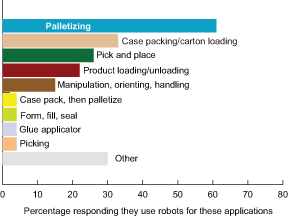CDC unsure of progress in fighting foodborne illnesses
Campylobacter, Listeria, Salmonella, Shigella, E. coli O157, Vibrio and Yersinia did not decline significantly, and the estimated incidence of Cryptosporidium increased when compared with the three previous years (2004-2006). Although there have been significant declines in the incidence of some foodborne infections since surveillance began in 1996, these declines all occurred before 2004.
“The results show that prevention efforts have been partly successful, but there has been little further progress in the most recent years,” says Dr. Robert Tauxe, deputy director of the CDC’s Division of Foodborne, Bacterial and Mycotic Diseases. Tauxe adds that more work needs to be done to make our food safer.
According to the report, Salmonella outbreaks caused by contaminated peanut butter, frozen pot pies and a puffed vegetable snack in 2007 underscore the need to prevent contamination of commercially produced products. Yet, at the same time a USDA FSIS testing program showed declines of Salmonella in poultry (broiler chicken carcasses) from 16.3% in 2005 to 11.4% in 2006 and 8.5% in 2007.
Unfortunately, declines in the incidence of E. coli O157 infections in 2003 and 2004 have not been maintained. Despite interventions from beef processors and FSIS to reduce ground beef contamination, 21 beef product recalls for possible contamination with STEC O157 were issued in 2007, 10 of which were illness associated, representing an increase compared with previous years.
Risk factors for many of these diseases still remain high for children under five years of age. Therefore, CDC encourages consumers to follow safe food handling and preparation techniques.
The CDC report can be found online at www.cdc.gov/mmwr (Morbidity and Mortality Weekly Report). Look for Volume 57, number 14 (week of April 11, 2008). For more information on FoodNet, visit, www.cdc.gov/foodnet.
Robots do the heavy lifting
Of the 200 packagers interviewed, 22% use packaging machinery with three or more axes, and 21% are planning to use robotics in the next five years. Robotics usage often accounts for more than one application at a packager’s site and continues to grow with palletizing (61% of respondents) and case/carton packaging (33%) being the most widely used applications for packaging robots. Pick-and-place applications were selected by 26% of the respondents.
The primary reasons packagers initially added robotics to packaging lines were to reduce costs, achieve higher efficiencies, reduce the labor force and increase manufacturing flexibility. According to PMMI supplier members, robotics usage has almost doubled from five years ago-from an average of 9.5% of packaging lines having robotics to 17.4% today. In addition, robotics usage is expected to continually grow rapidly over the next five years.
More than 75% of packagers with robotics equipment in their lines expect to see an increase in robotics usage in the next five years. PMMI member suppliers agree that food and food preparation is currently the largest robotics market. Packagers for chemicals, food and beverages and pharmaceuticals are the most likely to have robotics on their packaging lines.
More than 90% of packagers have given their robots good grades, saying robots are successful in performing their jobs, and nearly 80% of packagers interviewed think robots are important to their packaging operations. The food and durable goods industries rated the importance of robotics slightly higher than other industries. The most popularly mentioned desires for future systems include vision systems, increased speed and greater flexibility.Corn prices too high?
But according to an LECG LLC study entitled The Relative Impact of Corn and Energy Prices in the Grocery Aisle, the actual relationship between ethanol, corn and retail food prices is less clear. Well-known consultant and professor and LECG director, John Urbanchuk, author of the study, says that a 33% increase in crude oil prices (which translates to a $1.00 per gallon increase in the price of conventional gas) results in a 0.6% increase in the CPI for food while an equivalent increase in corn prices ($1.00 per bushel) would cause the CPI for food to increase only 0.3%.
According to USDA’s most recent statistics, some industries are affected more than others by rising corn prices. For example, a 2-liter soda uses 15 oz. of corn in HFCS sweetener. At $3.40 per bushel (the average price of corn in 2007), the cost of the corn in the soda is 5.7 cents compared with 3.8 cents when corn was $2.28 per bushel (the 20-year average).
Currently about 55% of the corn produced in the
Outsourcing requires homework
FULL STORY
Features
Plant of the Year: Barilla says, Ciao, New York !
FULL STORY
Tech Update: Antimicrobial tools
FULL STORY
Dry Processing Technology
FULL STORY
Recalls are a fact of life
FULL STORY

People, Plant and Industry News
Bulkflow Technologies, Inc. has changed its corporate name to Solex Thermal Science, Inc. to more accurately reflect the strengths and value the company offers to its customers. The privately held company specializes in the science of heating, cooling and drying of free-flowing bulk solids.
Mettler-Toledo Safeline appointed Dick Wyman as X-ray regional sales manager and Cary Chapman as field service manager.
Aquionics appointed Kevin Shannon as its new vice president of sales and marketing. He was senior product marketing manager with responsibility for a portfolio of electrical equipment products at Schneider Electric-Square D.
Hawk, a global provider of level, positioning and flow measurement technology, announced a joint venture with Chongquin Sichuan Instrument Co., the largest instrumentation company in
The Klöckner Pentaplast Group appointed Jay Cheng as general manager for the company’s Asia/Pacific Rim operations. Cheng will assume the overall responsibility for all KP activities, operations and sales offices in the region, including the plant in
Flooring specialist Flowcrete Group plc appointed Ian Dawson to the newly created position of global marketing manager.
Applied Manufacturing Technologies, Inc. (AMT), a leading supplier of factory automation design, engineering and process consulting services acquired K-R Automation, a Warren, MI-based automation controls design, engineering and panel manufacturing company.
Powerit Solutions named Jim Peterson, a veteran of the food processing industry, to its advisory board to assist the company in providing additional expertise to food processing companies to lower their energy costs.
The Profibus Trade Organization (PTO) appointed Victor Wolowec as the latest addition to the PTO board of directors. Wolowec is vice president, solutions business at Endress+Hauser.
The FDT (Field Device Tool) Group plans technical seminars in Calgary, AB on May 28; Houston, TX on September 25 and Greenville, SC on October 28. The free one-day seminars feature technical presentations and live demonstrations using HART, FOUNDATION fieldbus and Profibus using FTD-DTM’s technology. For more information, see www.fdtgroup.org/events.
Siemens Energy & Automation was awarded a project valued at more than $1 million to modernize the automation system at the Bayer CropScience site in Institute, WV, with a Simatic PCS 7 distributed control system.
Applied Vision, provider of machine vision inspection systems for the container manufacturing industry, appointed Bud Patel to vice president of sales. Patel joined the company in 2001.
Multivac has joined with JohnsonDiversey, a global provider of commercial hygiene solutions, to deliver a customized sanitation plan to every customer purchasing a Multivac packaging system with a CIP option.
Michael Forstner assumed overall responsibility for the O-Ring division of the Parker Seal Group Europe. He succeeds Markus Becker, who has moved to the Parker Tube Fittings Division Europe.
Flowcrete Group plc, an international flooring company, as acquired by US-based RPM International Inc., a multinational holding company with subsidiaries that manufacture and market high-performance coatings, sealants and specialty chemicals.
Thiele Technologies agreed to acquire the intellectual property and certain assets of Nigrelli Systems, Inc. of
Industrial services provider MISCOR Group, Ltd. named Edward Matheny as VP of sales and marketing for its Repair, Remanufacturing and Manufacturing (RPM) division. Matheny comes from GE Energy-Industrial Services, where he spent more than 18 years in integrated sales and marketing.